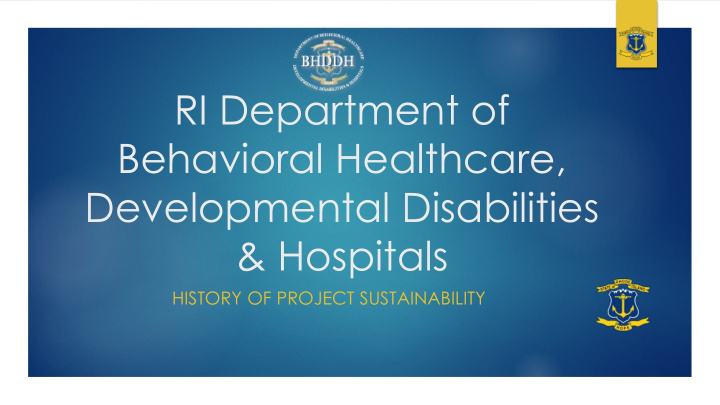



RI Department of Behavioral Healthcare, Developmental Disabilities & Hospitals HISTORY OF PROJECT SUSTAINABILITY
Project Sustainability – Planning Phase • In the Spring of Calendar Year (CY) 2010, BHDDH initiated a system-wide reform of the way that it offers, delivers and pays for services for persons with intellectual and developmental disabilities (I/DD), known as “ Project Sustainability .” • BHDDH sponsored two meetings with family members, self advocates and other stakeholder advocates in October 2010 and January 2011 to explain project activities to date and created three workgroups to discuss: • Service Definitions, Service Rates and an Assessment Tool • At the completion of the workgroup meetings and after the May 2011 Public Notice was released, BHDDH sponsored open forums for stakeholders across the state to explain the activities completed to date and to describe what was to come. • Six meetings were held in May and June 2011 prior to initiation of Project Sustainability.
Project Sustainability – Phase I: Initiation • Phase I was implemented July 1, 2011 through June 30, 2012 . In this phase, a number of changes occurred within the I/DD delivery system. Each existing service was reviewed and, in many cases, redefined in an effort to better state BHDDH’s expectations from its providers and to better communicate to participants what should be provided under each service. • Some new services were added and the method of paying for services changed: • Prior to 7/1/2011, providers were paid one monthly amount for residential-related services and a separate amount for day activity services. • Effective 7/1/2011, each of the 18 services available to consumers were given their own rate. • Services were billed on a fee-for-service basis • Providers billed for day services • Higher rates were paid for employment in an integrated setting than other community-based services
Project Sustainability – Phase II Additional Research & Outreach Phase II of BHDDH’s reforms began immediately after Phase I was implemented through December 2012 . The key objectives of Phase II were to: Most appropriately align resources to each participant’s needs by establishing a standardized and tested assessment for each individual. • SIS Assessments began • Use the information from the assessments to develop service tiers based on participants’ needs • Five Service Tiers were developed • Provide tools for participants and their families to make informed choices about the services they would like to receive • Inform participants of authorization amounts to select services to purchase and choose the providers of those services • Use the information gathered through the new utilization data reported to inform policies to incentive services being delivered in the most integrated setting possible • Analyze trends and use that information to inform policy
Project Sustainability – Phase III Full Implementation In Phase III of Project Sustainability which took effect January 1, 2013 , BHDDH’s key objectives were to: • Convert all current participants to the new service tier system by March 31, 2014 • BHDDH staff convened participant and family forums throughout the state in the 1st Quarter of CY 2013 to explain the SIS assessment, service tiers, ISPs, and Purchase Order more fully. • Bring all new participants on to the new service tier system upon enrollment • Assess participants once every three years • Continue to build incentives in the system through rates, outcome measures, education and communications to increase community integration in both residential placement and day activities • BHDDH required providers to separately bill for center-based, community-based and home-based day programs in addition to the employment-related services. • Beginning in January 2013, the rates paid for community-based day activities were increased while center-based day rates were held steady or reduced.
Recommend
More recommend